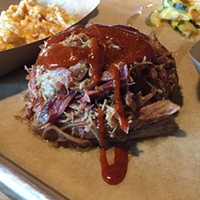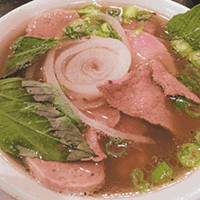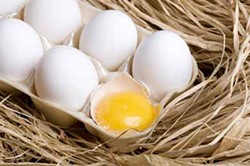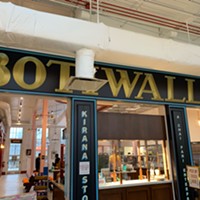In the mid-1990s, the trend had been for restaurants to pull the local food engine along. Thirteen years ago, farmers like Sammy Koenigsberg of New Town Farms began growing specific food items for chefs who requested them for their menus. Surplus of these foods made their way into area farmers markets, and soon home cooks could buy local fingerling potatoes for dinner.
That was then. Now the restaurant industry faces the greatest economic challenge of a generation. Since September 2008, more than one restaurateur has described his sales as "falling off the edge." We have all seen the casualties of the recession, the empty spaces. What restaurants had to do in order to survive was to "go to the mattresses" and cut back in any way they could. Gone from the plate are garnishes. Gone, too, are attributions for the origination of the food since area restaurants have curtailed their purchases of local products. Koenigsberg wrote in a recent e-mail to his CSA (Community Supported Agriculture): "Restaurant sales have suffered this year, and we don't believe that will ease any time soon." Subsequently, his farm sold more farm shares to local consumers.
Chefs put it another way. "I call it 9/11, but it doesn't end. It's still frozen," says Chef Blake Hartwick of Andrew Blair. He says he tries to buy locally "within reason, but it's hard to buy a lot of things" because he cannot charge more. The problem isn't that chefs do not want to use local products; it's the customer not willing to pay for it -- at a restaurant. One restaurateur estimated that median entrée prices fell from a high of $38 in late 2007 to $25 today. This means that a customer, who may have been willing to pay $38 for an entrée two years ago, would pay one third less today. In an industry with close margins, that's a significant reduction.
But what about locally grown foods? Do they cost that much more? Industry standards refer to organic produce nationally as priced 20 to 25 percent higher than non-organic produce. But local farmers say that their foods are in line with overall pricing. Marianne Battistone, who owns Poplar Ridge Farm, a certified-organic CSA located in Waxhaw, says that her weekly boxes to her share holders are "fair market priced." She says, "People have figured out that you get more than what you pay for." Prices do not keep people from buying her produce. When Poplar Ridge opened in 1994, Battistone needed to recruit people to become members, but since 2007, she has more requests than shares.
Cassie Parsons, co-owner of the Grateful Growers Farm in Lincoln County, goes further, saying that the cost of locally produced foods being higher is a "myth." She says that local food "should be judged by its quality and value, not only by price." Anyone who has had pork from her farm knows that there is a discernible difference.
For chefs wanting to buy local, the trick, then, is to be creative. For Hartwick, this means more braising: using the lesser cuts of meat and making them more flavorful.
While restaurants in Charlotte are finding a new paradigm, the desire on the home front to consume what is grown locally is increasing. Writer Michael Pollan may have scared people organic with his 2006 book The Omnivore's Dilemma, and if that didn't, the recent documentary Food, Inc. did. We are increasingly becoming a food-wary society. We prefer chemical-free fruits and vegetables, and organically raised, antibiotic- and hormone-free, humanely slaughtered meat.
Kathy Lee and her husband started Creekside Acres, 20 miles east of Charlotte in New Salem, four years ago. She says, "Our prices are higher, but we have a better product. For smaller organizations, things cost more. Some of our costs have gone up as well." The Lees do not have a CSA, but sell their products at their farm, all pre-ordered. They raise Droper lambs (which are slaughtered in the fall), make cheese, yogurt, buttermilk from their Jersey cows, and sell Golden Comet chicken eggs and Khaki Campbell duck eggs.
Lee says people now come on a regular basis. "Consumers are becoming more aware of the food industry and the government is not doing things in our best interests. They have a desire to know where their food is coming from and insure that it's not tainted and from a clean environment."
Battistone agrees. "Sixteen years ago, there was no awareness. But even prior to the economic downturn, food security had become an issue. People want to know where their food is coming from."
However, while the consumer is willing to pay $4 per dozen for locally grown organic eggs and $6.50 per pound for meat for home use, this has not translated to the necessary higher entrée price for these foods in area restaurants.
Know of a restaurant that has opened, closed, or should be reviewed? Does your restaurant or shop have news, menu changes, and new additions to staff or building, upcoming cuisine or wine events? To be included in our online blog, Eat My Charlotte, send information to Tricia via e-mail (no attachments, please): tricia.childress@creativeloafing.com.
Latest in Food & Drink Features
More by Tricia Childress
-

Seoul Food Meat Co's got soul
May 4, 2016 -

Aix en Provence flourishes in Myers Park
Apr 6, 2016 -

Pho and beyond at Saigon Bay Vietnamese Cuisine
Mar 2, 2016 - More »
Calendar
-

Haw River Wine Tasting @ Carolina Beer Temple.
-

Haw River Wine Tasting @ Carolina Beer Temple.
-

TRIVIA THURSDAYS!!! @ Elizabeth Parlour Room
-

LIVE MUSIC FRIDAYS: TRACE CASANOVA @ Elizabeth Parlour Room at Hooligans FC
-

Charlotte Grilled Cheese Festival @ SouthEnd Station.
-
Bernardin's celebrates 1/2 year anniversary
A glimpse into this upscale Uptown location, complete with photos.
-
Vegan CEO Talks Meatless Mondays and Learning the Lifestyle
Planting the seed
-
Back of the Box: No Boil Classic Lasagne 5
Not having to boil the noodles rocks!











